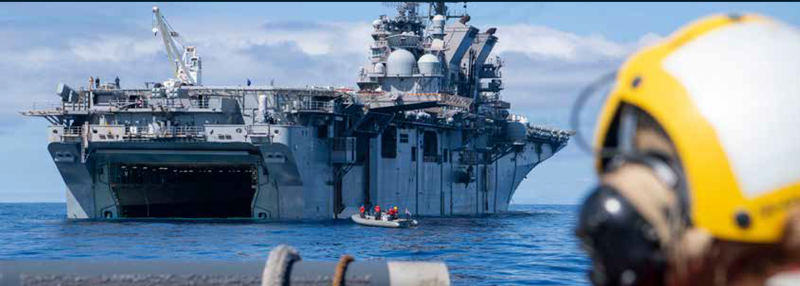Amateur Radio and the Future of National Security
By Eric Werny, Retired – Navy Radioman
In an era of advanced digital infrastructure, satellite communications, and global connectivity, it is vital to recognize the significant fragility of our communication systems. While metropolitan areas often have redundancy in their communications, rural areas tend to lack such support.
A Legacy of Service in Times of Crisis
From World War II to the aftermath of natural disasters like Hurricane Katrina, amateur radio operators have stepped in when other systems failed. Unlike commercial and governmental networks, amateur stations are decentralized, adaptable, and capable of establishing communications rapidly without relying on fragile centralized infrastructure.
Amateur operators were among the first to pass critical traffic during the 9/11 attacks when phone systems were overwhelmed. They continue to play a vital role in emergency operations centers across the country, providing backup links between agencies and communities.
In the United States, the various civil defense agencies were replaced with the Federal Emergency Management Agency (FEMA) in 1979. In 2002, this became part of the Department of Homeland Security after the September 11, 2001, attack on the twin towers in New York.
Vulnerabilities in Modern Communications
National security increasingly relies on data being transmitted across fiber optic cables, undersea links, and satellite networks. These systems, while highly efficient, are also vulnerable to the following. This is a brief subjective list.
HUMAN:
- Cyberattacks on networks, data centers, hubs, and human-accessible systems to disrupt cabling.
- War – International, Rebellions, be that Regional, Local.
- Anti-satellite weapons.
- Human Intervention By The Overuse of Resources.
- Wide-area Electrical Power Shutdowns Due To System Failures.
- Political Actor Sabotage In Land, Sea, and Air.
- Natural Gas Explosions.
- Wildfires are causing massive evacuations.
- Construction and excavation
- Major Aircraft Accidents in Populated Areas, where local communications are brought to over capacity.
- Roadway Disruptions Due To Major Accidents And Bridge Failures.
- Railroad Derailments Also With Toxic Chemicals In Populated Areas.
- Failure of the Governmental Organization To Provide Leadership and Services.
- Overwhelmed infrastructure, such as cellular, landline telephone, Satellite communications, and the Internet. With loss of electrical power, most systems with backup provisions are only available for up to seventy-two hours.
- In a major conflict or large-scale disaster, the loss of these networks could leave government agencies and citizens cut off from vital information.
NATURAL:
- Earthquake
- Volcanic Eruption
- Volcanic Ash
- Landside
- Rockfall
- Standard Weather Patterns – Unusual Hot and Cold Temperatures
- Hurricanes, Tornadoes, and Monsoons
- Lighting Storms
- Derechos
- Blizzards
- Ice Storms
- Hailstroms
- Floods and Flash Floods
- Coastal Fooding
- Wildfires and Firestorms
- Dust Storms
- Tsunami
- Geomagnetic storms
- Pest Infestations
HEALTH, WELFARE, AND LOGISTICAL COMMUNICATIONS
In major events, high-priority messages that protect life and property take precedence, along with the logistics for Amateur Radio Communication systems.
EMERGENCY ALERT SYSTEM (EAS)
In the United States, the various civil defense agencies were replaced with the Federal Emergency Management Agency (FEMA) in 1979. In 2002 this became part of the Department of Homeland Security.
640 kHz and 1240 kHz on the a.m. broadcast band are not actively used for civil defense; they were part of the Cold War-era CONELRAD system, which has been replaced by the modern Emergency Alert System (EAS).
Amateur radio—operating on independent power, with flexible frequency access and worldwide reach—offers a resilient alternative. Unlike cellular towers or internet exchanges, a simple HF transceiver and wire antenna can span continents without external infrastructure.
The Strategic Role of Amateur Radio
The Department of Defense and the Federal Emergency Management Agency (FEMA) have already recognized amateur radio’s value. Programs such as MARS (Military Auxiliary Radio System) work closely with amateur operators to maintain a pool of trained communicators who can assist in times of national crisis. MARS is still active through the ARMY and Air Force, but disbanded by the Navy in 2015.
Looking ahead, amateur radio could support national security in three critical ways:
- Resilient Emergency Communications – Serving as a decentralized safety net when conventional systems fail.
- Technical Innovation – Advancing digital modes, weak-signal propagation, mesh networks, and SDR (software-defined radio) technologies that can be adapted for broader defense use.
- Public Preparedness & Civil Defense – Encouraging citizens to be communication-capable during emergencies, strengthening the resilience of communities nationwide.
The Next Ten Years: Integration, Not Isolation
Rather than existing on the fringe of technology, amateur radio is poised to integrate with modern tools. SDR platforms, internet-linked repeaters, and hybrid emergency networks that blend ham radio with secure digital systems will define the next decade. In a high-stakes scenario where cyberwarfare or infrastructure sabotage threatens the U.S., having a trained cadre of licensed operators who can bridge communication gaps could prove decisive.
The Shedding Of Technology During Massive Failures
As infrastructure failures grow during coupled disasters, going back to the basics in communications will prevail.
There are those who claim that cellular networks will be the saving grace with satellite communications, but those will be the primary targets during a conflict.
Conclusion
Amateur radio is more than a hobby—it is a living infrastructure of resilient, independent communicators. For the United States, it represents not just a backup plan but a strategic advantage in maintaining continuity of communication during emergencies. As threats evolve, national security planners should continue to embrace and expand collaboration with the amateur radio community.
The future of amateur radio is not only about experimentation and fellowship—it is about ensuring the nation can speak, listen, and respond when it matters most.

